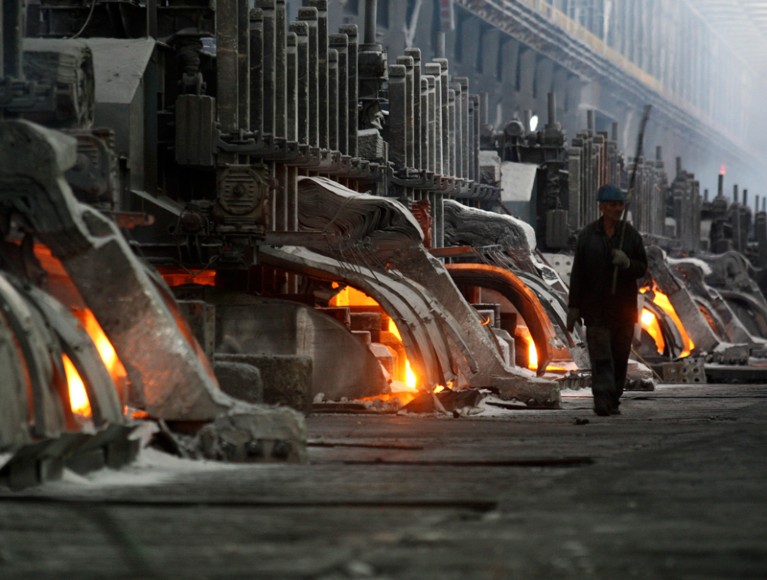
New technology could slash the carbon emissions of aluminium smelting.Credit: Nozim Kalandarov/Reuters
The world produced more than 63 million tonnes of aluminium last year, which went into everything from kitchen foil and cans to aircraft. The metal is lightweight, fully recyclable and surprisingly strong. And now, two leading aluminium companies say that it will soon be clean and green. But just like electric cars, making aluminium can ultimately be only as clean as its source of power.
On 10 May, the US manufacturer Alcoa joined with British–Australian firm Rio Tinto to announce a new joint venture, Elysis. Based in Montreal, Canada, it plans to roll out a low-carbon technology for smelting aluminium by 2024. Alcoa and Rio Tinto will invest a combined Can$55 million (US$43 million). Elysis has also attracted a total of Can$120 million from the governments of Canada and Quebec, and Can$13 million from computing firm Apple, which is seeking low-emissions aluminium for its devices. Canadian Prime Minister Justin Trudeau called the occasion “a truly historic day for the aluminum industry”.
The world will surely benefit if Elysis lives up to its promise. Aluminium production accounts for 1% of global greenhouse-gas emissions each year — roughly equivalent to emissions from France in 2016. It’s a two-step process: refine aluminium oxide powder from bauxite ore and then convert it to aluminium in smelters. The bulk of the industry’s climate footprint is from the smelting process, which requires prodigious quantities of electricity. More than half of its total emissions come indirectly from the electricity production itself.
Here’s the opportunity: nearly 20% of the emissions are from the production and degradation of the carbon anodes used to conduct electricity during smelting. And this is where the new process focuses.
Details are scant, but observers of the aluminium industry will not be surprised to hear that the Elysis technology focuses on a long-standing issue and involves a proprietary inert anode — probably a ceramic composite. Instead of releasing CO2 and perfluorocarbons, it emits oxygen. This would completely eliminate the direct carbon emissions, but does require more electricity. If paired with alternative cathodes and new designs for the electrolytic cell, however, it would be possible to reduce electricity consumption.
Alcoa claims that the technology will reduce operating costs by 15% and increase aluminium output by the same amount. And if fully implemented at all of the Canadian smelters, it would reduce emissions by an estimated 6.5 million tonnes each year, according to the company. Experts warn that it could be difficult to simply retrofit existing smelters, because the efficiency of the process is affected not just by anodes and cathodes, but also by the design of the electrolytic cell. But the good news is that companies replace these cells every 6–8 years, so Elysis certainly has a market for its product.
That all sounds good. But this isn’t the first time that a major aluminium producer has talked up revolutionary smelting technology. Russian firm UC Rusal, for instance, has been seemingly on the cusp of developing inert anodes for several years. Alcoa’s work goes back several decades and included a big push around 2000. The problem has long stymied academics and government researchers, too.
Industry deserves credit for continuing to invest in long-term research and development, and for not giving up on a difficult problem. But even if Elysis does succeed, aluminium production will still yield emissions from mining, aluminium oxide processing and transport. One thing industry can do is to ensure that companies and consumers recycle as much aluminium as possible, because it doesn’t need to be smelted. But the biggest question is where producers get the electricity.
Companies have already begun locating aluminium smelters near hydroelectric facilities, which provide relatively cheap and reliable power. Alcoa has even moved some of its smelting operations from the United States to Iceland, which provides cheap geothermal electricity. In the end, Alcoa and Rio Tinto are like everybody else. They need a reliable source of low-carbon power to reduce their climate impact — and the cheaper the better.

 The allure of aluminium
The allure of aluminium
 3D printing of high-strength aluminium alloys
3D printing of high-strength aluminium alloys




